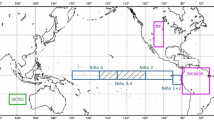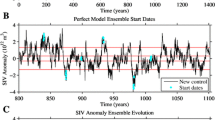Abstract
An assessment of the ability of the Met Office seasonal prediction system, GloSea4, to accurately forecast Arctic sea ice concentration and extent over seasonal time scales is presented. GloSea4 was upgraded in November 2010 to include the initialization of the observed sea ice concentration from satellite measurements. GloSea4 is one of only a few operational seasonal prediction systems to include both the initialization of observed sea ice followed by its prognostic determination in a coupled dynamical model of sea ice. For the forecast of the September monthly mean ice extent the best skill in GloSea4, as judged from the historical forecast period of 1996–2009, is when the system is initialized in late March and early April near to the sea ice maxima with correlation skills in the range of 0.6. In contrast, correlation skills using May initialization dates are much lower due to thinning of the sea ice at the start of the melt season which allows ice to melt too rapidly. This is likely to be due both to a systematic bias in the ice-ocean forced model as well as biases in the ice analysis system. Detailing the forecast correlation skill throughout the whole year shows that for our system, the correlation skill for ice extent at five to six months lead time is highest leading up to the September minimum (from March/April start dates) and leading up to the March maximum (from October/November start dates). Conversely, little skill is found for the shoulder seasons of November and May at any lead time.









Similar content being viewed by others
Notes
This data has since been reprocessed though 2009.
The GloSea4 analysis and NSIDC trends are closer together if one considers only the 1996–2007 period where GloSea4 has a consistent set of sea ice observations.
In the sense that these forecasts were performed prior to September 2011 and 2012.
References
Arribas A, Glover M, Maidens A, Peterson K, Gordon M, MacLachlan C, Graham R, Fereday D, Camp J, Scaife AA, Xavier P, McLean P, Colman A, Cusack S (2011) The GloSea4 ensemble prediction system for seasonal forecasting. Mon Weather Rev 139(6):1891–1910. doi:10.1175/2010MWR3615.1
Balmaseda M, Anderson D, Vidard A (2007) Impact of Argo on analyses of the global ocean. Geophys Res Lett 34(6):L16605. doi:10.1029/2007GL030452
Balmaseda M, Ferranti L, Molteni F, Palmer T (2010) Impact of 2007 and 2008 Arctic ice anomalies on the atmospheric circulation: implications for long-range predictions. QJRMS 136(652):1655–1664. doi:10.1002/qj.661
Barsigli J, Battisti D (1998) The basic effects of atmosphere–ocean thermal coupling on midlatitude variability. J Atmos Sci 55:477–493. doi:10.1175/1520-0469(1998)055<0477:TBEOAO>2.0.CO;2
Bitz CM, Holland MM, Hunke EC, Moritz RE (2005) Maintenance of the sea-ice edge. J Clim 18:29032921. doi:10.1175/JCLI3428.1
Blanchard-Wrigglesworth E, Armour KC, Bitz CM, DeWeaver E (2011a) Persistence and inherent predictability of Arctic sea ice in a GCM ensemble and observations. J Clim 24(1):231–250. doi:10.1175/2010JCLI3775.1
Blanchard-Wrigglesworth E, Bitz CM, Holland MM (2011b) Influence of initial conditions and climate forcing on predicting Arctic sea ice. Geophys Res Lett 38(18). doi:10.1029/2011GL048807
Blockley EW, Martin MJ, McLaren AJ, Ryan AG, Waters J, Lea DJ, Mirouze I, Peterson KA, Sellar A, Storkey D (2014) Recent development of the met office operational ocean forecasting system: an overview and assessment of the new global foam forecasts. Geosci Model Dev Discuss 6(4):6219–6278. doi:10.5194/gmdd-6-6219-2013
Budikova D (2009) Role of Arctic sea ice in global atmospheric circulation: a review. Glob Planet Change 68(3):149–163. doi:10.1016/j.gloplacha.2009.04.001
Butterworth P, English S, Hilton F, Whyte K (2002) Investigation into optimal observation errors for satellite winds. Tech. Rep. NWPSAF\_MO\_TR\_007, Met Office, UK. http://research.metoffice.gov.uk/research/interproj/nwpsaf/satwind_report/trialsdir/nwpsaf_mo_tr_007.pdf
Casey K, Brandon T, Cornillon P, Evans R (2010) The past, present and future of the AVHRR Pathfinder SST program. In: Barale V, Gower J, Alberotanza L (eds) Oceanography from space: revisited. Springer, Berlin. doi:10.1007/978-90-481-8681-5_16
Cavalieri D, Parkinson C, Gloersen P, Zwally HJ (1996, updated yearly) Sea ice concentrations from Nimbus-7 SMMR and DMSP SSM/I passive microwave data. http://nsidc.org/data/nsidc-0051.html
Cavalieri DJ, Parkinson CL, Gloersen P, Comiso JC, Zwally HJ (1999) Deriving long-term time series of sea ice cover from satellite passive-microwave multisensor data sets. J Geophys Res 104:15,803–15,814
Chevallier M, y Mélia DS, Voldoire A, Déqué M, Garric G (2013) Seasonal forecasts of the pan-Arctic sea ice extent using a GCM-based seasonal prediction system. J Clim 26:60926104. doi:10.1175/JCLI-D-12-00612.1
Clayton AM, Lorenc AC, Barker DM (2013) Operational implementation of a hybrid ensemble/4d-var global data assimilation system at the met office. Q J R Meteorol Soc 139(675):1445–1461. doi:10.1002/qj.2054
Comiso J, Cavalieri D, Parkinson C, Gloersen P (1997) Passive microwave algorithms for sea ice concentration: a comparison of two techniques. Remote Sens Environ 60:357–384
Dee D, Berrisford P, Poli P, Fuentes M (2009) ERA-interim for climate monitoring. ECMWF Newslett 119:5–6
Defant A (1924) Die schwankungen der atmosphärischen zirkulation über dem nordatlantischen ozean im 25-jährigen zeitraum 1881–1905. Geogr Ann 6:13–41
Fereday DR, Maidens A, Arribas A, Scaife AA, Knight JR (2012) Seasonal forecasts of northern hemisphere winter 2009/10. Environ Res Lett 7(3):034031. http://stacks.iop.org/1748-9326/7/i=3/a=034031
Fetterer F, Knowles K, Meier W, Savoie M (2002, updated 2011) Sea ice index. Boulder: National Snow and Ice Data Center. Digital Media. http://nsidc.org/data/g02135.html
Francis JA, Vavrus SJ (2012) Evidence linking Arctic amplification to extreme weather in mid-latitudes. Geophys Res Lett L06801. doi:10.1029/2012GL051000
Francis JA, Chan W, Leathers DJ, Miller JR, Veron DE (2009) Winter northern hemisphere weather patterns remember summer Arctic sea ice extent. Geophys Res Lett 36(L07):503. doi:10.1029/2009GL037274
Guemas V, Doblas-Reyes F, Mogensen K, Keeley S, Tang Y (2014) Ensemble of sea ice initial conditions for interannual climate predictions. Clim Dyn 1–17. doi:10.1007/s00382-014-2095-7
Hasselmann K (1976) Stochastic climate models part I. theory. Tellus 28(6):473–485. doi:10.1111/j.2153-3490.1976.tb00696.x
Hewitt HT, Copsey D, Culverwell ID, Harris CM, Hill RSR, Keen AB, McLaren AJ, Hunke EC (2011) Design and implementation of the infrastructure of HadGEM3: the next-generation Met Office climate modelling system. Geosci Model Dev 4(2):223–253. doi:10.5194/gmd-4-223-2011
Hunke EC, Lipscomb WH (2010) Cice: the Los Alamos sea ice model documentation and software users manual, version 4.1. LA-CC-06-012, Los Alamos National Laboratory
Ineson S, Scaife AA, Knight JR, Manners JC, Dunstone NJ, Gray LJ, Haigh JD (2011) Solar forcing of winter climate variability in the northern hemisphere. Nat Geosci 4:753–757. doi:10.1038/ngeo1282
James IN, James P (1989) Ultra-low-frequency variability in a simple atmospheric circulation model. Nature 342:53–55. doi:10.1038/342053a0
Kim KY, North GR (1998) EOF-based linear prediction algorithm: theory. J Clim 3046–3056: doi:10.1175/1520-0442(1998)011<3046:EBLPAT>2.0.CO;2
Kim KY, North GR (1999) EOF-based linear prediction algorithm: examples. J Clim 2076–2092. doi:10.1175/1520-0442(1999)012<2076:EBLPAE>2.0.CO;2
Kumar A, Bhaskar J, Zhang Q, Bounoua L (2007) A new methodology for estimating the unpredictable component of seasonal atmospheric variability. J Clim 20:3888–3901
Large W, Yeager S (2009) The global climatology of an interannually varying airsea flux data set. Clim Dyn 33(2–3):341–364. doi:10.1007/s00382-008-0441-3
Laxon S, Peacock N, Smith D (2003) High interannual variability of sea ice thickness in the Arctic region. Nature 425:947–950. doi:10.1038/nature02050
Lindsay RW, Zhang J (2006) Assimilation of ice concentration in an ice-ocean model. J Atmos Oceanic Technol 23:742749. doi:10.1175/JTECH1871.1
Lindsay RW, Zhang J, Schweiger AJ, Steele MA (2008) Seasonal predictions of ice extent in the Arctic ocean. J Geophys Res Oceans 113(C2). doi:10.1029/2007JC004259
MacLachlan C, Arribas A, Peterson K, Maidens A, Fereday D, Scaife A, Gordon M, Vellinga M, Williams A, Comer RE, Camp J, Xavier P (2014) Description of GloSea5: the Met Office high resolution seasonal forecast system. in preparation for QJRMS
Madec G (2008) NEMO ocean engine. Tech. Rep. Note du Pole de modélisation No 27, ISSN No 1288–1619, Institut Pierre-Simon Laplace (IPSL), France
Maidens A, Arribas A, Scaife A, MacLachlan C, Peterson D, Knight J (2012) Predictability of the North Atlantic Oscillation in early winter 2010–2011. Submitted to Monthly Weather Review
Marshall AG, Scaife AA, Ineson S (2009) Enhanced seasonal prediction of European winter warming following volcanic eruptions. J Clim 22:6168–6180. doi:10.1175/2009JCLI3145.1
Martin M, Hines A, Bell M (2007) Data assimilation in the FOAM operational short-range ocean forecasting system: a description of the scheme and its impact. QJR Meteorol Soc 133:981–995
McLaren AJ, Banks HT, Durman C, Gregory J, Johns T, Keen A, Ridley J, Roberts M, Lipscomb W, Connolley W, Laxon S (2006) Evaluation of the sea ice simulation in a new coupled atmosphere–ocean climate model (HadGEM1). J Geophys Res 111(C12):014. doi:10.1029/2005JC003033
Merryfield W, Lee WS, Boer GJ, Kharin VV, Scinocca JS, Flato G, Ajayamohan RS, Fyfe JC, Tang Y, Polavarapu S (2012) The Canadian seasonal to interannual prediction system: part I. Models and initialization. Submitted to Monthly Weather Review
Merryfield WJ, Lee WS, Wang W, Chen M, Kumar A (2013) Multi-system seasonal predictions of Arctic sea ice. Geophys Res Lett 40(8):1551–1556. doi:10.1002/grl.50317
Notz D (2009) The future of ice sheets and sea ice: between reversible retreat and unstoppable loss. Proc Natl Acad Sci 106(49):20590–20595. doi:10.1073/pnas.0902356106
OSI-SAF (2011) EUMETSAT ocean and sea ice satelitte application facility. Global sea ice concentration reprocessing dataset 1978–2009 (v1.1, 2011). http://osisaf.met.no
Overland JE, Wang M (2010) Large-scale atmospheric circulation changes are associated with the recent loss of Arctic sea ice. Tellus A 62(1):1–9. doi:10.1111/j.1600-0870.2009.00421.x
Rayner NA, Parker D, Horton E, Folland C, Alexander L, Rowell D, Kent E, Kaplan A (2003) Global analyses of sea surface temperature, sea ice, and night marine air temperature since the late nineteenth century. J Geophys Res 108:4407. doi:10.1029/2002JD002670
Roberts-Jones J, Fiedler EK, Martin MJ (2012) Daily, global, high-resolution SST and sea ice reanalysis for 1985–2007 using the OSTIA system. J Clim 25:6215–6232. doi:10.1175/JCLI-D-11-00648.1
Schweiger A, Lindsay R, Zhang J, Steele M, Stern H, Kwok R (2011) Uncertainty in modeled Arctic sea ice volume. J Geophys Res Oceans 116(C8). doi:10.1029/2011JC007084
Sigmond M, Fyfe JC, Flato GM, Kharin VV, Merryfield WJ (2013) Seasonal forecast skill of Arctic sea ice area in a dynamical forecast system. Geophys Res Lett. doi:10.1002/grl.50129
Smith DM (1996) Extraction of winter sea ice concentration in the Greenland and Barents seas from SSM/I data. Int J Remote Sens 17:2625–2646
Stark J, Ridley J, Martin M, Hines A (2008) Sea ice concentration and motion assimilation in a sea ice ocean model. J Geophys Res 113:C05S91. URL http://www.agu.org/pubs/crossref/2008/2007JC004224.shtml
Storkey D, Blockley E, Furner R, Guiavarc’h C, Lea D, Martin M, Barciela R, Hines A, Hyder P, Siddorn J (2010) Forecasting the ocean state using NEMO: the new FOAM system. J Oper Oceanogr 3:3–15. http://www.ingentaconnect.com/content/imarest/joo/2010/00000003/00000001/art00001
Stroeve J, Holland MM, Meier W, Scambos T, Serreze M (2007) Arctic sea ice decline: faster than forecast. Geophys Res Lett 34(9). doi:10.1029/2007GL029703
Thompson DWJ, Wallace JM (1998) The Arctic Oscillation signature in the wintertime geopotential height and temperature fields. Geophys Res Lett 25:1297–1300
Tivy A, Alt B, Howell S, Wilson K, Yackel J (2007) Long-range prediction of the shipping season in Hudson Bay: a statistical approach. Weather Forecast 22:1063–1075. doi:10.1175/WAF1038.1
Walker GT, Bliss EW (1932) World weather V. Mem Roy Meteor Soc 4(36):53–84
Wang W, Chen M, Kumar A (2013) Seasonal prediction of Arctic sea ice extent from a coupled dynamical forecast system. Mon Weather Rev 141:1375–1394. doi:10.1175/MWR-D-12-00057.1
Woollings T, Lockwood M, Masato G, Bell C, Gray L (2010) Enhanced signature of solar variability in Eurasian winter climate. Geophys Res Lett 37(L20):805
Acknowledgments
This work was supported by the Joint DECC/Defra Met Office Hadley Centre Climate Programme (GA01101) and the UK Public Weather Service research program. The authors would like to thank two anonymous reviewers for their comments leading to an improved manuscript.
Author information
Authors and Affiliations
Corresponding author
Electronic supplementary material
Below is the link to the electronic supplementary material.
Rights and permissions
About this article
Cite this article
Peterson, K.A., Arribas, A., Hewitt, H.T. et al. Assessing the forecast skill of Arctic sea ice extent in the GloSea4 seasonal prediction system. Clim Dyn 44, 147–162 (2015). https://doi.org/10.1007/s00382-014-2190-9
Received:
Accepted:
Published:
Issue Date:
DOI: https://doi.org/10.1007/s00382-014-2190-9




